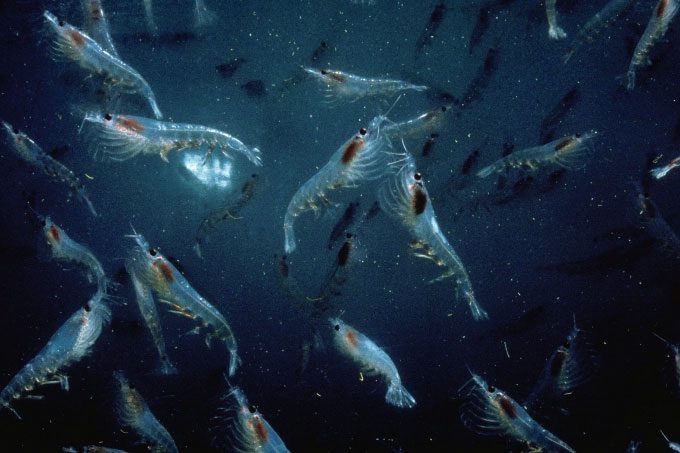The Antarctic, a mysterious land covered in ice and snow, remains one of the least explored areas by humans.
A “Treasure” at the Bottom of the Sea
Recently, a Chinese scientific expedition inadvertently discovered a “hidden treasure” in the waters off the Antarctic coast, which seems to be waiting for human exploration.
According to the Global Times (China), this area is so rich in resources that it has been dubbed a “marine food storehouse”, teeming with various species of fish, birds, seals, and whales. Among them, the estimated biomass of krill in Antarctica is about 1 billion tons, believed to be sufficient to feed 1.4 billion people.
The Antarctic krill, resembling small shrimp but much smaller in size, averages 4-6 cm in length, reaching a maximum of 9 cm and weighing only around 2 grams.
Every year, humans and other marine creatures consume hundreds of millions of tons of krill. However, the global krill population remains stable at around 30 billion tons. Scientists have discovered that up to 30,000 krill can be found in each cubic meter of seawater.
Notably, the Antarctic krill has a remarkable reproductive capacity, with a female capable of laying up to 10,000 eggs at once. The number of offspring produced exceeds the number that are consumed.
This species also exhibits vigorous resilience. Although the Antarctic environment is extremely harsh, it poses no problem for them. Krill eggs sink to the ocean floor at depths of 2,000 meters to hatch.
With no natural predators in this area, they can safely grow to maturity.

Antarctic Krill. (Photo: People’s Daily).
Even without food, krill can survive for up to 200 days. During molting periods, they shed their old exoskeleton and quickly reduce their body size before the new shell hardens, which helps minimize the energy required to keep their bodies afloat.
This unique skill allows krill to survive the long, harsh winters.
Antarctic krill is also a protein-rich food source. According to the Chinese Academy of Sciences, Antarctic krill meat contains 17.56% protein, 2.11% fat, and all essential amino acids needed by the human body.
Notably, in terms of lysine content, which represents rich nutritional properties, Antarctic krill has the highest lysine level compared to tuna, shrimp, and beef. The World Health Organization once compared the lysine nutritional values of Antarctic krill, shrimp, cow’s milk, and beef, with results showing krill scored 100 points, beef 96 points, cow’s milk 91 points, and shrimp 71 points.
Due to its large biomass and high nutritional value, Antarctic krill is dubbed the “gold mine of the sea” and is considered the “future grain storehouse” for humanity to alleviate the resource crisis.
Low Catch Yields
As early as the 1980s, the Soviet Union began harvesting krill in Antarctica, followed by Japan and Norway.
Norway is the largest producer, with an annual catch of about 200,000 tons. China ranks second with 118,000 tons. However, global catch yields remain very low, totaling only about 500,000 tons, likened to “a drop in the ocean.”
The low yield of krill harvesting in Antarctica is due to the species’ tendency to self-digest at low temperatures and their rapid decomposition.
If harvested but not processed efficiently in time, the nutritional content of krill significantly diminishes. This raises higher demands for harvesting, preservation, and transportation technologies.
Secondly, deep processing technology is essential. Antarctic krill cannot be consumed directly due to their strong fishy odor and high fluoride content in their shells, which can cause fluorosis and pose life-threatening risks if eaten raw. Therefore, they are often processed into capsules.
The limited capacity for deep processing downstream affects the upstream catch volume. Overall, the global catch of Antarctic krill remains relatively small.


















































